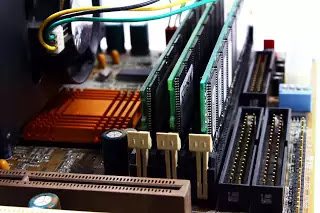Hello friends and welcome again to your own tech guide: Techanalysia. So today we are to going to see that, what makes a smartphone fast? Is it RAM or Processor? One can't choose between RAM and Processor while determining a device's performance.
RAM or Processor: What makes a smartphone fast?
The answer to the above question is, both. RAM and Processor are both responsible for the smooth and lag-free performance of your smartphone.
Let's take a look at how these two play an important role in a smartphone.
First thing first, the type of rams used in smartphones are DDR RAMs. In particular, the RAM used in smartphones is technically called LPDDR RAM. This term stands for 'Lower Power Double Data Rate RAM. These LPDDR RAMs are the version of DDR RAMS specially designed for smartphones.
These RAMs are optimized for low power consumption because these RAMs are used inside smartphones which are having a small battery compared to PC/Laptop in which DDR RAMs are employed.
These types of RAMS have to be optimized based on the power consumption. The operating voltage of this LPDDR RAM is less compared to the DDR RAMs.
The term DDR in RAM stands for 'Double Data Rate'. In this type of RAM, the data is transferred twice during each clock cycle of the CPU, with rising and falling edges. Different generations of LPDDR RAMs are LPDDR1/LPDDR2/LPDDR3/LPDDR4. In each generation of DDR RAM, the speed of the RAM was increased and power consumption has been reduced. You'll find LPDDR4 RAM in most smartphones, but now in some premium segment smartphones, LPDDR5 RAMs are being used. LPDDR5 RAM just consumes 0.5 volts compared to 1.1 volts of LPDDR4 and some studies claim that the LPDDR5 RAMs are about 30% more power-efficient than LPDDR4 RAMs.
Read Also: What is RAM?
Now, after all these technical terms let's look at what RAM does in a smartphone? And what does RAM do in smartphones?
As most of us know that RAM is Random Access Memory. It is a much faster memory compared to your permanent storage. When Processor computes data it's faster to retrieve data required from processing your RAM instead of loading it from your permanent storage which takes much time. Also, it's less taxing on the battery of your phone when your CPU retrieves data from RAM instead of from storage.
The RAM works quite differently on your phones than on your PC and Laptops which most of us basic users are familiar with. The Apps you download and install are first loaded in the RAM and then executed. Those apps remain in the RAM after you are no longer using them and they have shifted to the background. The next time you see those apps they will be available for fast retrieval from the RAM unless they have been removed. When you continuously use apps, the apps that you use most frequently get placed on your RAM that is if you have enough RAM.
Read Also: TN vs VA vs IPS | Which is best display panel for gaming?
The purpose of RAM in mobile phones is to facilitate faster access to files. These files are not documents, PDFs, etc. But are the supportive files that are necessary to run any app and even the software of the phone.
For example, whenever you run an application, let's say a game, all the supportive files get loaded into RAM first. These are the files responsible for the graphics of the game and video, network connectivity, sensing the motion of the device, and many such functions. In the case of an operating system, the supportive files are those which render the touch functioning of the device, the sim connectivity, etc.
On the other hand, Faster CPU results in speedy operations. By operations, I mean the speed of opening apps, the speed with which a click responds, better background processing, and general smoothness in operation. And a faster CPU depends upon its architecture, clock speed, and the number of cores.
Conclusion
Both are very important. Both the ram and processor are responsible for the smooth performance of a smartphone. A powerful CPU allows you to compute data very quick. That means faster app opening, faster web page load, faster game, etc. More RAM, on the other hand, lets your phone handle more tasks at once. In simple terms, more RAM can let more apps run in the background without slowing your phone down.
So, it ends here and I hope you liked it. And if you learned something new today then please let me know in the comment section down below and share it with your friends.

Very insightful...
ReplyDeleteKeep up the work👍🏼
Thanx.. keep reading and sharing
ReplyDeletethank you for simplifying the information.
ReplyDeleteThanks for reading. If you like it then please share it with your friends
DeleteI am very thankful to you that you have shared this information with us. Read more info about Current Trending Tech News Online. I got some different kind of knowledge from your web page, and it is really helpful for everyone. Thanks for share it.
ReplyDeleteThanks. If you found this informative and helpful then please share it with your family and friends.
Delete